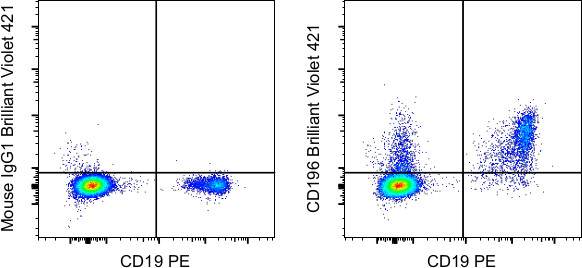Search Thermo Fisher Scientific
Invitrogen
CD196 (CCR6) Monoclonal Antibody (R6H1), Brilliant Violet™ 421, eBioscience™
图: 1 / 1
CD196 (CCR6) Antibody (404-1969-42) in Flow

产品信息
404-1969-42
种属反应
宿主/亚型
分类
类型
克隆号
偶联物
激发/发射光谱
形式
浓度
纯化类型
保存液
内含物
保存条件
运输条件
产品详细信息
Description: This R6H1 monoclonal antibody reacts with CD196 (also known as CCR6), a seven transmembrane G protein-coupled receptor expressed on T, B, dendritic, natural killer, and Langerhans cells. This CC chemokine receptor uniquely binds MIP-3a/CCL20, a chemoattractant for dendritic cells, effector/memory T cells, and B cells. CD196 is also involved in host defense and inflammation at epithelial sites. Furthermore, this receptor has been implicated in Th17 differentiation and CD4+FoxP3+ regulatory T cell development.
Applications Reported: This R6H1 antibody has been reported for use in flow cytometric analysis.
Applications Tested: This R6H1 antibody has been pre-diluted and tested by flow cytometric analysis of . This may be used at 5 µL (0.5 µg) per test. A test is defined as the amount (µg) of antibody that will stain a cell sample in a final volume of 100 µL. Cell number should be determined empirically but can range from 10^5 to 10^8 cells/test.
Brilliant Violet™ 421 (BV421) is a dye that emits at 423 nm and is intended for use on cytometers equipped with a violet (405 nm) laser. Please make sure that your instrument is capable of detecting this fluorochrome.
When using two or more Super Bright, Brilliant Violet™, Brilliant Ultra Violet™, or other polymer dye-conjugated antibodies in a staining panel, it is recommended to use Super Bright Complete Staining Buffer (Product # SB-4401-42) or Brilliant Stain Buffer™ (Product # 00-4409-75) to minimize any non-specific polymer interactions. Please refer to the datasheet for Super Bright Staining Buffer or Brilliant Stain Buffer for more information.
Excitation: 407 nm; Emission: 423 nm; Laser: Violet Laser.
BRILLIANT VIOLET™ is a trademark or registered trademark of Becton, Dickinson and Company or its affiliates, and is used under license. Powered by Sirigen.™
靶标信息
CCR6 is a member of the beta chemokine receptor family, which is predicted to be a seven transmembrane protein similar to G protein-coupled receptors. The gene is preferentially expressed by immature dendritic cells and memory T cells. The ligand of this receptor is macrophage inflammatory protein 3 alpha (MIP-3 alpha). This receptor has been shown to be important for B-lineage maturation and antigen-driven B-cell differentiation, and it may regulate the migration and recruitment of dentritic and T cells during inflammatory and immunological responses. Alternatively spliced transcript variants that encode the same protein have been described for this gene.
仅用于科研。不用于诊断过程。未经明确授权不得转售。
How to use the Panel Builder
Watch the video to learn how to use the Invitrogen Flow Cytometry Panel Builder to build your next flow cytometry panel in 5 easy steps.
篇参考文献 (0)
生物信息学
蛋白别名: C-C chemokine receptor type 6; C-C CKR-6; CD196; chemokine (C-C motif) receptor 6; chemokine (C-C) receptor 6; Chemokine receptor-like 3; CKR-L3; CKR6; DRY-6; DRY6; G protein-coupled receptor 29; G-protein coupled receptor 29; GPR-CY4; GPRCY4; LARC receptor; seven-transmembrane receptor, lymphocyte, 22
基因别名: BN-1; C-C CKR-6; CC-CKR-6; CCR-6; CCR6; CD196; CKR-L3; CKRL3; CMKBR6; DCR2; DRY6; GPR29; GPRCY4; STRL22
UniProt ID: (Human) P51684
Entrez Gene ID: (Human) 1235




